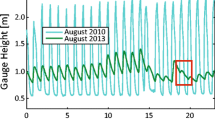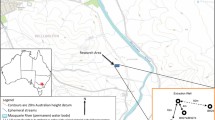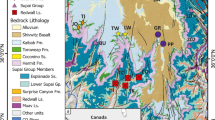Abstract
The importance of groundwater in the dissolved organic matter (DOM) budget of small upland streams is not well understood. This paper is concerned with the amount of streamflow which can be attributed to groundwater, the organic chemistry of rainwater, streamwater, and groundwater, and the rate of transfer of DOM in groundwater to the streams of a small mountain catchment basin in Alberta. Using naturally occurring isotopes (18O and tritium) groundwater is concluded to be the largest contributor to stream discharge throughout the year. This means that most of the water which reaches the stream must pass through the soil column and be exposed to microbial attack. Groundwater in the Marmot Basin spends an average of about ten years in the ground before being discharged into streams. In this area it appears that the majority of DOM from forest productivity is consumed in the soil and only small amounts of refractory by-products reach the stream. This is in keeping with the finding of Fisher & Likens (1973) that 99% of forest productivity is consumed terrestrially. It is probable that bacteria in stream sediments are capable of taking up refractory compounds which deep soil bacteria can not. Increases in DOM concentration in streams are not usually observed during storm runoff because of the ability of bacteria to take up groundwater DOM and because most of stream discharge is groundwater low in DOM being flushed into the channel even during snowmelt and rainfall events.
Similar content being viewed by others
References
Anonymous, 1971. Standard methods for the examination of water and wastewater. American Public Health Association, American Water Works Association, Water Pollution Control Federation 13th ed. Boyd Printing Co.
Beke, G., 1969. Soils of the Marmot Basin, Streeter Basin, and Red Deer Basin. PhD Thesis, University of Alberta.
Dubois, M. et al., 1956. Colorimetric method for determination of sugars and related substances. Analyt. Chem. 28 (3): 350.
Fisher, S. G. & G. E. Likens, 1972. Stream ecosystem: Organic energy budget. Bioscience 22: 33–35.
Fisher, S. G. & G. E. Likens, 1973. Energy flow in Bear Brook, New Hampshire: An integrative approach to stream ecosystem metabolism. Ecol. Monogr. 43: 421–439.
Fritz, P., J. A. Cherry, K. U. Weyer & M. Sklash, 1976. Storm runoff analyses using environmental isotopes and major ions, in: Interpretation of Environmental Isotope and Hydrochemical data in Groundwater Hydrology-Inter. Atomic Energy Agency, Vienna.
Hackett, W. F., W. J. Conners, T. K. Kirk & J. G. Zerkus, 1977. Microbial decomposition of synthetic 14C labelled lignins in nature; lignin biodegradation in a variety of natural materials. Applied Environ. Microbiol. 33: 43–51.
Handa, N., 1966. Distribution of dissolved carbohydrate in the Indian Ocean. J. Oceanogr. Soc. Japan 22 (2): 16–22.
Hoefs, J., 1973. Stable Isotope Geochemistry. Springer-Verlag pub.
Klute, A., 1967. The movement of water in unsaturated soils. Presented at the M.I.T. Summer Session on Groundwater Hydrology and Flowthrough Porous Media.
Maciolek, J. A., 1962. Limnological organic analyses by quantitative dichromate oxidation. Res. Rep. 60, U.S. Dept. of the Interior.
Otsuki, A. & R. G. Wetzel, 1973. Interaction of yellow organic acids with calcium carbonate in freshwater. Limnol. Oceanog. 18 (3).
Pinder, G. F. & J. F. Jones, 1969. Determination of the groundwater component of peak discharge from the chemistry of the total runoff. J. Wat. Res. 5 (2): 438–445.
Roach, D. & C. W. Gehrke, 1969a. Direct esterification of the protein amino acids for gas-liquid chromatography of NTFA n-butyl esters. J. Chromatog. 44: 269–278.
Roach, D. & C. W. Gehrke, 1969b. The gas-liquid chromatography of amino acids. J. Chromatog. 43: 303–10.
Rowe, J. S., 1972. Forest Regions of Canada. Can. For. Serv. Pub. No. 1300.
Sklash, M. G., 1978. The role of groundwater in storm and snowmelt runoff generation. Ph.D. Thesis — University of Waterloo.
Stalker, A., Mac S., 1973. Surficial geology of the Kananaskis research forest and Marmot Creek basin region of Alberta. Geol. Surv. Can. Paper 72–51.
Stevenson, D. R., 1967. Geological and groundwater investigations in the Marmot Creek Experimental Basin of southwestern Alberta, Canada. M.Sc. Thesis — University of Alberta.
Stevenson, D. R., 1974. Preliminary analyses of the groundwater flow systems in Marmot Creek and Streeter Basins, Alberta, Canada. Unpublished report — Research Council of Alberta.
Storr, D., 1977. Some preliminary water balances of Marmot Creek sub-basins. Alberta Watershed Research Programme Symposium, September 1977, Edmonton, Alberta.
Swanson, R. H., 1975. Water use by mature lodgepole pine. Proc. Symp. Management of Lodgepole Pine Ecosystems. Ed. D. M. Baumgartner-Washington State University Cooperative Extension Service (pub.).
Telang, S. A., B. L. Baker, J. W. Costerton & G. W. Hodgson, 1975. Water quality and forest management: the effects of clear cutting on organic compounds in surface waters of the Marmot Creek drainage basin. Report to Environment Canada, Inland Waters Directorate.
Telang, S. A., B. L. Baker, G. W. Hodgson, J. W. Costerton, G. G. Geesey, R. A. Mutch & P. Wallis, 1976. Water quality and forest management: Chemical and biological processes in a foreststream ecosystem of the Marmot Creek Drainage Basin. ibid.
Author information
Authors and Affiliations
Additional information
This work was supported by a Subvention from Environment Canada, Inland Waters Directorate, and partly by an operating grant from the National Research Council of Canada.
This work was supported by a Subvention from Environment Canada, Inland Waters Directorate, and partly by an operating grant from the National Research Council of Canada.
Rights and permissions
About this article
Cite this article
Wallis, P.M., Hynes, H.B.N. & Telang, S.A. The importance of groundwater in the transportation of allochthonous dissolved organic matter to the streams draining a small mountain basin. Hydrobiologia 79, 77–90 (1981). https://doi.org/10.1007/BF00005821
Received:
Issue Date:
DOI: https://doi.org/10.1007/BF00005821




